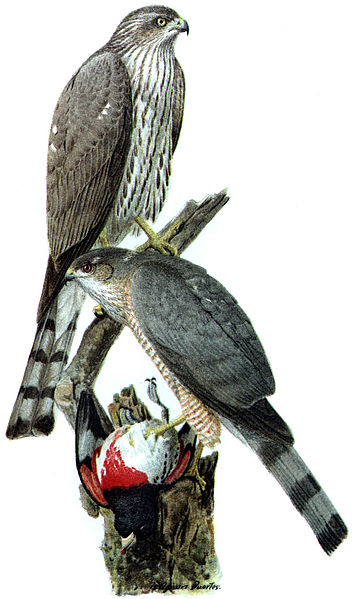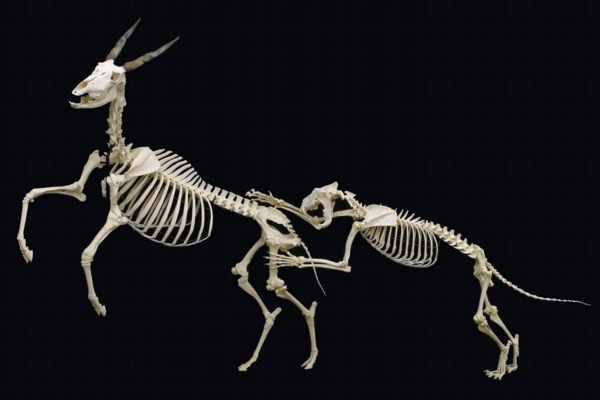
Illustration by Allan Lasser
Animals feel a 'landscape of fear' – just like humans
Afraid of lions by moonlight and raptors by day, animals will behave in dramatic ways
Anyone who has ever watched a horror movie late at night while home alone understands how fear can affect behavior. You may be on high alert, checking door locks, tip-toeing down hallways, and taking the long route through your house to avoid passing windows. This (probably) isn't how you behave in the light of day.
Animals respond the same way to the threat of predation. When predators like hawks, leopards, and lions are around, prey animals, like small birds, squirrels, and gazelles, begin to see their environments as a mosaic of safe and dangerous places. Ecologists term this phenomenon the "landscape of fear," and we are just beginning to learn just how strongly hearing bumps in the night can affect animal behavior.
In a new paper in the journal Ecology, Blair Dudeck and colleagues from Western University in Ontario examined how fear affects parental care by adult song sparrows, and quantified how severely having scared parents affects baby birds.

A sparrow horror show
USDA
Baby sparrows, like most birds, rely on their parents for food. In fact, a 2011 study by this same research group published in Science found that fearful birds feed their offspring less. This led to the starvation deaths of 1 in 5 baby birds because their parents were too afraid of being preyed on by ravens and hawks to bring them sufficient food.
But young song sparrows are at risk even after they leave the nest. Before they become completely independent at 21 days of age, they need their parents to teach them how to find food and to identify the dangerous birds of prey. Young birds also vocalize to beg for food from their parents, which can reveal their locations to predators. The researchers observed that offspring of the fearful parents were more likely to beg regardless of whether or not the predators were around, and they reasoned that the effects of the landscape of fear on bird survival likely extended beyond babyhood.
To quantify this, Dudeck and colleagues set up a follow-up experiment to the 2011 project. They played predator and non-predator sounds to juvenile song sparrows while the adults were in the vicinity to assess the impact of predator presence on both fledgling and parent behavior. They collected data on the young birds' body weights and survival to independence, and then looked for differences in the bird families exposed to predator and non-predator sounds.
The impact of fear on the survival of the young sparrows was undeniable. Parents who were exposed to the predator sounds fed their offspring 44 percent less than parents who heard non-predator sounds. The young birds exposed to the predator sounds showed no recognition of the potential threat and continued to beg for food from their parents. These two things together, the researchers calculated, resulted in the offspring of the frightened parents dying earlier. By their estimate, fear itself caused a 53 percent reduction of juvenile sparrow survival.
Fear of the waning moon
If that isn't spooky enough, another group of researchers, led by Meredith Palmer of the University of Minnesota, recently set out to figure out how the landscape of fear in Serengeti National Park changes according to the light of the moon. Everyone has heard the myth of how the full moon causes people to turn into werewolves, but in Serengeti, the main threat to wildlife is the African lion.
Using 14,000 photos compiled over three years from 225 remotely-operated cameras (a technique called camera trapping), along with the known geographic locations of 2,915 lion kills provided by the Serengeti Lion Project, the team examined how the position and phase of the moon affect the nocturnal movement patterns and associated predation risk of African buffalo, Thomson's gazelle, common wildebeest, and plains zebra. Lions are most active at night, so the scientists predicted that these four prey species might be more likely to forage in risky areas under the illumination of the full moon – and take refuge in safer areas at other times of the lunar cycle.

The spooky hunt
Like a group of pre-schoolers trick-or-treating for the first time, the four prey species each navigate the landscape of fear differently. Wildebeest are the most cautious of the bunch, choreographing their movements to match the available moonlight and minimize their risk of attack by their lion predators. The buffalo, on the other hand, are the bravest prey. They clearly chased available food resources, and there was no sign that their movements were designed to avoid lions or track the moon.
Zebras move unpredictably across the landscape, presumably to keep lions from guessing their locations. During the rainy season when risky habitats contain lots of energy-rich grass, the zebra more often venture into dangerous habitats, but only when moonlight is bountiful. And Thomson's gazelle, the smallest of all the prey in the study, minimize their risk of being eaten by gathering in groups after the moon had risen. They also forage mainly in areas where the risk of lion attacks was relatively low.
So if you feel unnerved trick-or-treating in the dark on Halloween, remember that your heightened sense of risk is shared by vulnerable prey in land and seascapes around the world, to the point that it can even affect the population sizes of these animals.
Perhaps this bit of ecological knowledge will help all of us feel slightly less ridiculous when we find ourselves tiptoeing around our homes after watching a scary movie. Next time you are peeking around doorways on a dark night with baseball bat in hand, just think - somewhere in the Serengeti, there's a wildebeest behaving just like you.
Peer Commentary
Jack Barton: The effect of 'fear' on the survival of the sparrows was stark, to say the least. I wonder if that effect would be even greater in a natural environment where the young sparrows cries would have likely resulted in death for them and their parents.
Ashley Juavinett: I can't believe I'm going to be this person, but do we really know animals feel fear? We know that they respond to predators, and that they change their actions in response to their environment, but we still can't say they feel fear like we do. There is, unfortunately, little way to know if it has the same subjective quality for other animals (or even other humans... cue high-pitched organ).
Regardless, I will still imagine I am a wildebeest when I sneak into my kitchen to make mac 'n' cheese late at night. Thank you for that.
Cassie Freund responds: I'm comfortable with using the term fear because it's a way to make the audience understand and relate to what I'm writing. It's kind of the same as the recent article on how plants can smell... plants can't smell like we do, but it's a great way to make people understand the complex science.
Jennifer Howard: I really like that we have multiple examples of fear in this article – it helps give the reader more evidence that animals other than humans do experience fear at some level. Additionally, research published in the Journal of Animal Ecology in 2016 examined the landscape of fear in the common fruit fly, Drosophila melanogaster. In this study, flies were exposed to the scent of a predator (a mantid) during breeding and non-breeding seasons. Flies that were exposed during the non-breeding season had much higher mortality and lost weight compared to a control group of flies that weren’t exposed to the scent. These flies that survived exposure to the scent of a predator were monitored during their breeding season and were found to produce fewer offspring than the control group. Flies exposed during the breeding season didn’t produce fewer offspring, but the offspring developed faster and weighed less than the control group; the predator’s scent still affected offspring growth. It is really interesting that we are starting to quantify this landscape of fear across organisms of different taxa and sizes, and I am sure we will continue to see more evidence of this in upcoming years.
